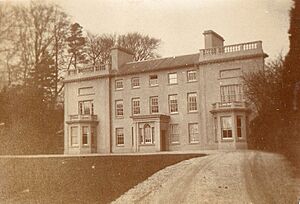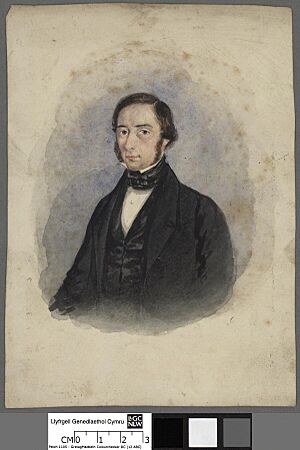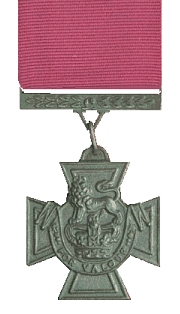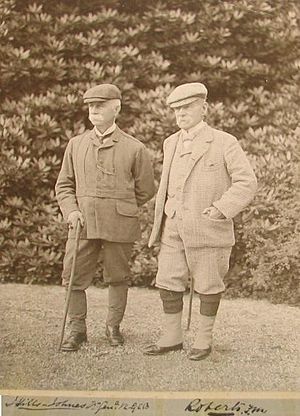Dolaucothi Estate facts for kids
The Dolaucothi Estate is a historic place in Wales, located about 1 kilometer north-west of a village called Caio. It sits in the beautiful Cothi Valley in Carmarthenshire. The name Dolaucothi means ‘the meadows of the Cothi’, named after the nearby River Cothi.
In medieval times, a large house was built here, overlooking the river. The Johnes family rebuilt it. By 1873, the estate was very large, covering over 3,000 acres. You could reach Dolaucothi House by two long drives. One passed by the ancient Dolaucothi Gold Mines, which were used by the Romans. The other was lined with old oak trees. A writer named George Borrow walked along this path in 1854 and loved the "very noble oaks" and the "pleasing locality."
Contents
The Johnes Family and Dolaucothi
The Dolaucothi Estate came into the Johnes family in the late 1500s. This happened when James Johnes, who was a Sheriff in Cardiganshire, married Anne. Anne was the heir to the previous owners of Dolaucothi.
James Johnes was the youngest son of Sir Thomas Johnes, an important Member of Parliament. Sir Thomas was also a Sheriff for Carmarthenshire and Cardiganshire.
Later, in 1800, a man named John Johnes (1768–1815) bought the estate. He was an army captain and bought it from his cousin, Colonel Thomas Johnes. Colonel Thomas Johnes was a well-known landowner who owned another famous estate called Hafod.
The House's Design
Dolaucothi House was rebuilt in the early 1700s. It had a grand front with five sections and three floors. It kept some older parts from 1679. The house was described as "simple and dignified." It was built in a cube shape and had 28 rooms.
In 1792, a famous architect named John Nash was hired to add a porch and two low wings to the house. Each wing had a window set into an arch. Nash had just finished working on another project for Colonel Thomas Johnes at Hafod.
Captain John Johnes' son, also named John (1800–1876), became a judge. He ordered many updates to the house, including adding bay windows in 1871. In its best days, Dolaucothi had nine staff working inside the house and eighteen more working on the estate grounds. The house was known for its charming interiors, filled with many portraits and war trophies belonging to General Hills, a famous military hero.
Sir James Hills-Johnes, a War Hero
Sir James Hills (1833–1919) was a brave military leader. He received the Victoria Cross, which is the highest award for bravery in the British military. He was a hero of the Indian Mutiny and was once the Military Governor of Kabul.
In 1882, Sir James married Elizabeth Johnes, who was the younger sister and co-heiress of the Dolaucothi Estate. Because of this marriage, Sir James added "Johnes" to his name and became Lieutenant-General Sir James Hills-Johnes. He then took over running the Dolaucothi Estate. He was also very involved in Welsh public life. He became an honorary colonel, a Justice of the Peace, and later the High Sheriff of Carmarthenshire. He received an honorary degree from University College Wales.
Lady Hills-Johnes, Sir James's wife, was well-connected and moved in fashionable circles. She corresponded with famous people, and her letters were even published. Dolaucothi House was always full of guests, including many important men and women. Among them were Field Marshal the Earl Roberts and Sir Henry Morton Stanley, a famous explorer of Africa.
Lord Roberts and Sir James were lifelong friends. They met as young cadets in military school. They both served in the military and faced dangers during the Indian Mutiny. They were both wounded and both received the Victoria Cross for their bravery. They continued to serve together in other campaigns.
The Johnes family's time at Dolaucothi eventually came to an end. Lady Hills-Johnes died in 1927. After their deaths, the estate passed through the female line to the Lloyds family, who also added "Johnes" to their name.
During World War II, the house was taken over by the government. It fell into very bad condition, with floors collapsing and parts of the roof being removed. In 1941, Dolaucothi was given to the National Trust, an organization that protects historic places. The last owner, Major Herbert Lloyd-Johnes, lived there until his death in 1956. After that, the National Trust fully owned the property. The main house was so damaged that it was torn down in 1952. Today, only a former service building remains, which is now a farmhouse.
St Cynwyl's Church
The Church of Saint Cynwyl is in Caio village, surrounded by what used to be the Dolaucothi Estate lands. The Johnes family were important supporters of this church and worshipped there. The family has a burial vault in the church that dates back to the 1700s. There is also a special memorial to Lieutenant-General Sir James Hills-Johnes, the Victoria Cross recipient, at the church's entrance gate.
Ogofau Gold Mine
The ancient Roman gold mines at Dolaucothi, also known as the Ogofau Gold Mine, were part of this large estate. People tried to find more gold from these mines at different times. John Johnes tried in 1797, and his son Judge John Johnes tried again in the 1850s and 1871 when new crushing machines were available.
Larger efforts to get gold happened from 1888 to 1892, and again from 1905 to 1910, and from 1933 to 1938. During the 1930s, Britain stopped using the gold standard, which made people much more interested in finding gold. Later attempts to find enough gold to sell for a profit have not been successful, but people are still interested in the gold deposits in the area.
Images for kids
-
Dolaucothi House pre-1871, as designed by John Nash.







